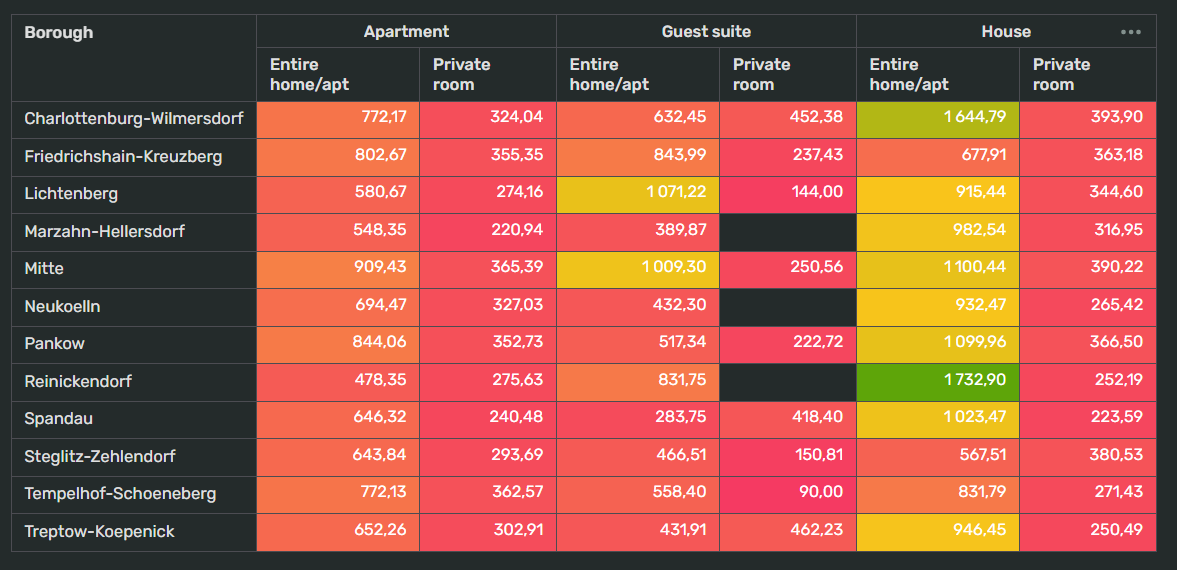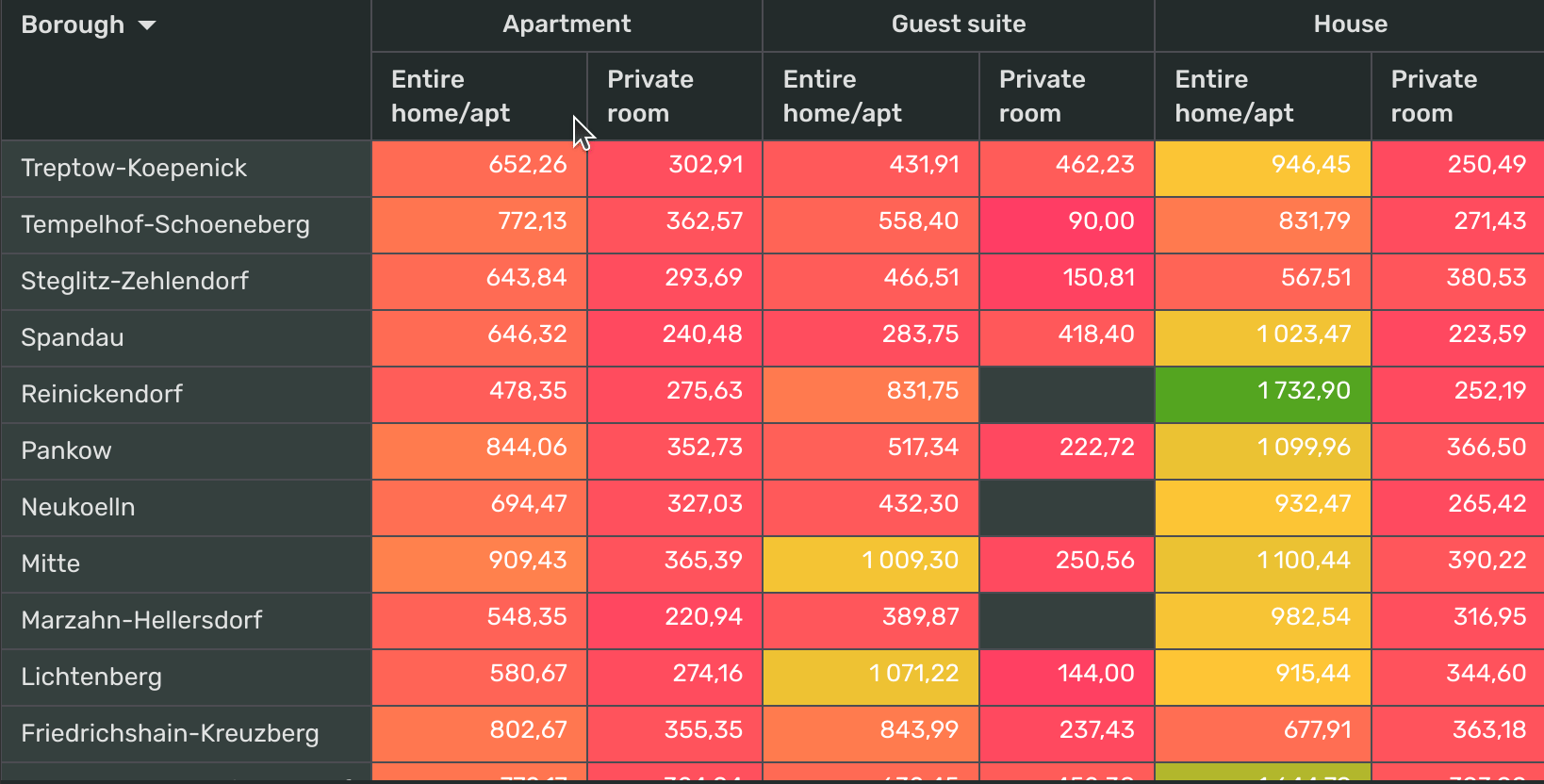Pivot table
A pivot table displays data in tabular form, where rows and columns contain source values, and the cells at their intersections contain the resulting values.
Pivot tables make it easier to work with large amounts of data and let you analyze the relationship between different measures.

For example, you can use this type of table to analyze accommodation type revenue by borough over a specific period.
AI-Insights supported
Use the AI-Insights feature with this chart type.
-
Open the All workbooks overview page and select your workbook.
-
Click Create → Wizard chart. You'll see the chart creation wizard.
-
On the top left, select the Dataset you want to visualize.
-
Click the chart type field on the right of the dataset section and select Pivot table from the drop-down menu.
-
Drag and drop Measures and Dimensions to the appropriate sections of the chart (see the Data fields tab).
Your chart creation wizard should look similar to the following:

-
Click Save in the upper-right corner of the page.
-
Name your chart and click Done.
-
Choose the appropriate location for your chart by dragging it around the dashboard and resize it by dragging the lower-right corner of its frame.
-
Click Save in the upper-right corner of the page.
| Wizard slot | Description |
|---|---|
| Columns | Dimensions that are used as columns. Field name is used as the column heading. |
| Rows | Dimensions that are used as rows. |
| Measures | Dimensions or Measures. If you add more than one field to this slot, a Measure Names field will appear in the Columns slot. It defines the position of the value headers.You can move the Measure Names field to the Rows slot. |
| Colors | Dimension or Measure. Affects the fill color of all the cells in a the table. |
| Sorting | Dimensions or Measures from the Columns slot. Multiple-field slot. Affects the sorting of the table fields. |
| Chart filters | Dimension or Measure. Used to filter values. |
To open data type settings, click the field type icon before the field name:
-
for
Integertype fields:Name
Description
Possible values
Name
Sets the name of the measure
A string of characters.
Type (Before aggregation)
Sets the field's data type.
Integer,Fractional number,String,Logical,Date,Date and timeAggregation
Applies a selected aggregation function to the data field.
No: doesn't apply aggregation. Count: applies the COUNT function, returns the total number of entries. Sum: applies the SUM function, returns the sum of all the field's values. Average: applies the AVG function, returns the arithmetic mean value. Minimum: applies the MIN function, returns the minimum value. Maximum: applies the MAX function, returns the maximum value. Count distinct: applies the COUNTD function to the data field and returns the number of unique values in the field.
Format
Sets the value display format
Number: display the values as plain numbers. Percent: show the values as a percentage.
Precision
Sets the number of characters displayed after the decimal point in a value.
Any positive integer.
Show thousands separator
Toggles the separation of groups of thousands.
Show: display spaces between groups of thousands. Hide: hide spaces between groups of thousands.
Prefix
Sets a text to display before the value
A string of characters.
Postfix
Sets a text to display after the value.
A string of characters.
Units
Sets a rounding scale to apply to the field's values.
Null: don't apply rounding.Auto: select and apply a rounding scale automatically.Thousands, K: round to thousands, display000asK.Millions, M: round to millions, display000 000asM.Billions, B: round to billions, display000 000 000asB.Trillions, T: round to trillions, display000 000 000 000asT.Sub-totals
Show subtotal values for row/column
Off- default state,On -
for
Stringtype fields:Name
Description
Possible values
Name
Sets the name of the dimension
A string of characters.
Type
Sets the field's data type.
Integer,Fractional number,String,Logical,Date,Date and timeAggregation
Sets the aggregation type
No: doesn't apply aggregation. Count: applies the COUNT function to the data field and shows the number total number of entries. Count distinct: applies the COUNTD function to the data field and returns the number of unique values in the field.
Sub-totals
Show subtotal values for row/column
Off- default state,On -
for
Datetype fields:Name
Description
Possible values
Name
Sets the name of the dimension
A string of characters.
Type
Sets the field's data type.
Integer,Fractional number,String,Logical,Date,Date and timeGrouping
Sets the grouping and rounding by time period.
No - doesn't apply grouping. Rounding - rounds the values by
Year,Quarter,Month,WeekorDay. Date part - returns the number of a time period:Year,Quarter,Month,Week,Day of week, orDay.Date mode
Toggles the date display mode.
Continuous - display all the dates continuously. Discrete - show the dates containing values.
Aggregation
Applies a selected aggregation function to the data field.
No: doesn't apply aggregation. Count: applies the COUNT function, returns the total number of entries. Minimum: applies the MIN function, returns the minimum value. Maximum: applies the MAX function, returns the maximum value. Count distinct: applies the COUNTD function to the data field and returns the number of unique values in the field. Average: applies the AVG function, returns the arithmetic mean value.
-
for
Geodatatype will convert intoInteger.
To open chart settings, click
| Control | Default state | Description |
|---|---|---|
| Header | Off |
Displays the specified text in the centered line above the chart. |
| Pagination | Off |
Shows pagination controls if the number of rows exceeds the number specified in the Limit setting. |
| Limit | 100 |
Sets the number of rows per page if pagination is enabled. |
| Old pivot tables | Off |
Allows you to use an obsolete logic of pivot tables, without coloring or in-chart calculations. Disables the Totals setting. |
Show totals
To calculate and show the Totals value, enable the Sub-totals for the first field in the Columns or Rows section.
After managing the controls, click Apply to see the results on the chart preview.
To open slot settings, click
Color:
On the left, you can select a line from a data source in the Colors slot of your chart.
On the right, you can select a color scheme and a color for the line. Select AUTO to let Visualization do the coloring for you.
-
To limit the size of a table, use filters or sorting. It's hard to read tables with many rows or columns.
-
Click the column header to sort the table by its value:

-
You can color table cells depending on the values of a measure. This will emphasize them.
-
This chart type can't display
NULLor negative values.